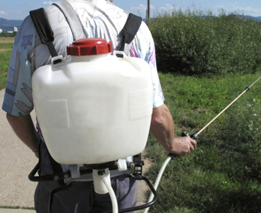Training Room 1: First Steps to Safety—Understanding Hazards
Project 1: Assessment of Potential Hazards in
Agricultural Settings—Creating a Health and Safety
Hazard Assessment Tool
Project Skill Level: Basic
Estimated Required Time: 2–3 hours (to be completed as you complete work in Training Room 1)
Project Introduction
This project will be completed as you work your way through this first training room. Training Room 1 will help you to learn about hazards in the workplace and specifically in agricultural areas. Although there are agricultural hazards common to all farms, each worksite is unique in the variety of hazards that are present, depending on the kind of farming that takes place. Your project will demonstrate how you can bring attention to possible hazards where you work.
Project 1: Health and Safety Hazard Assessment Tool
Your Task
Your project will require you to develop a Health and Safety Hazard Assessment Tool that is specific for your agricultural worksite or a worksite that you would choose to work on. This checklist will demonstrate that you have determined potential hazards on your worksite and are prepared to ask questions to bring attention to these hazards. You can use a variety of resources to help you develop your checklist.
-
Choose your focus. To develop your Health and Safety Hazard Assessment Tool, you will begin by choosing three areas of focus:
Select one of the following areas of focus:- farm machinery
- animal handling
AND
Select any two of the following farmyard environmental hazards, which you learned about in this training room’s Environmental Hazards session:
- noise
- fuel
- sun
- heat
- water
- human factors
Record your selected areas of focus on your Health and Safety Hazard Assessment Tool.
Example
Within each of your three areas of focus, keep in mind the various physical, chemical, biological and psychological hazards that could be present in your agricultural worksite. Be prepared to develop ten statements/questions for each of your three areas of focus.
What Hazard Do You Observe? What Makes This a Hazardous Situation? How Might Someone Get Injured Due to This Hazard? Checklist Statement or Question for Your Supervisor farm machinery: Keys for the tractor are left in it.

BasieB/iStockphoto/Thinkstock
- Find the information you need. Do some research to determine the particular hazards in the three areas of focus. You may want to use resources such as the following:
- videos, interactive activities, and text resources provided throughout the training room
- safety awareness materials currently available to you on your worksite
- discussions with supervisors and fellow employees at your worksite
- personal observations made when touring your worksite.
- videos, interactive activities, and text resources provided throughout the training room
- Design and create. For each of the three areas of focus you have chosen, develop a series of at least ten organized statements or questions that will bring attention to the hazards you have determined could be present at your farm.
Each statement or question should address important details of the hazards that need to be controlled for safety.
Example
What Hazard Do You Observe? What Makes This a Hazardous Situation? How Might Someone Get Injured Due to This Hazard? Checklist Statement or Question for Your Supervisor farm machinery: Keys for the tractor are left in it.
Someone who is not trained to use the machinery could turn it on.
Someone could get hurt if he or she is not prepared for the machinery to be turned on and running.Keys for machinery are removed when the machinery is not in use and are kept in a safe place.
Or
Are keys for machinery removed when the machinery is not in use?
Are keys kept in a prearranged safe place when not in use?
BasieB/iStockphoto/ThinkstockSomeone who is not wearing his or her personal protective equipment (PPE) could be exposed to hazardous chemicals.
A person spraying a field could come in contact with the hazardous chemical.Check the label for proper protective measures.
Or
Are there any protective measures required when using this product?
Is the operator familiar with the operation of this sprayer?
- Submit your work. You will submit a final copy of your Health and Safety Hazard Assessment Tool in the form that most suits you. It may be in any of the following formats:
Please remember to contact your teacher with questions, concerns, or requests for feedback while you are working on this project!
- checklist
- series of questions or questionnaire
- collection of images illustrating each hazard that requires assessment
Tools
Use the Project 1: Health and Safety Hazard Assessment Tool Planning Template to support your work. You can use this document to collect information to build your tool.
- The Self Assessment for Project 1 document needs to be completed midway through your work and upon completion of your work. This piece must be submitted to your teacher with your final project.
- The AGR 3000 Project Rubric will help you assess your progress and guide your work. This rubric will be used to assess your work and final project.
Final Submission
Submit both your project Health and Safety Hazard Assessment Tool and your Self-Assessment for Project 1 to your teacher.